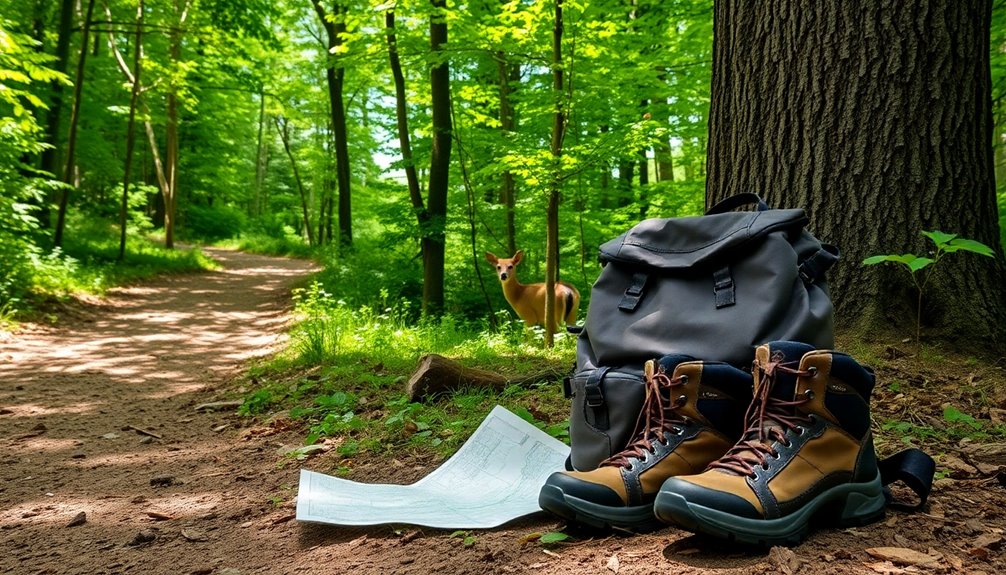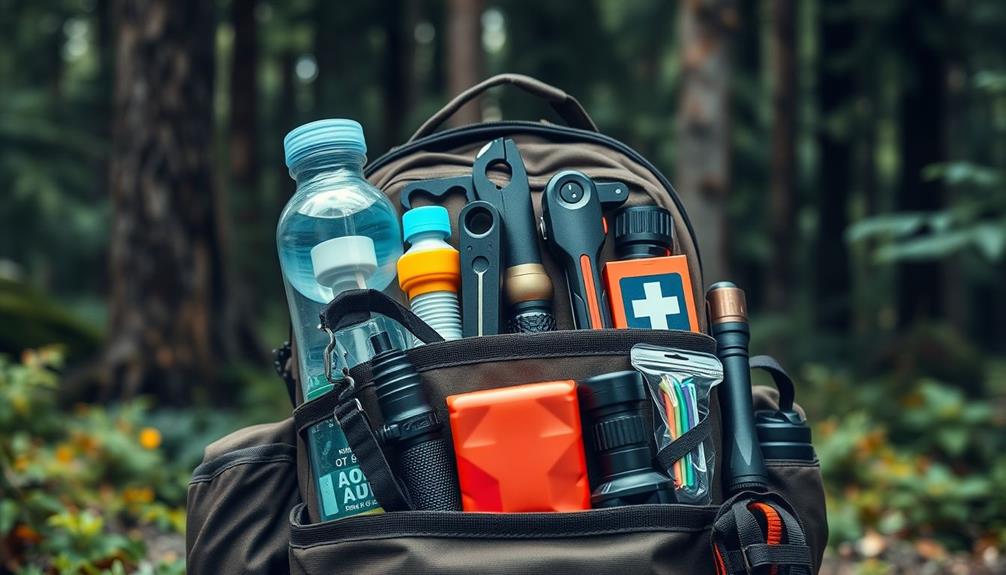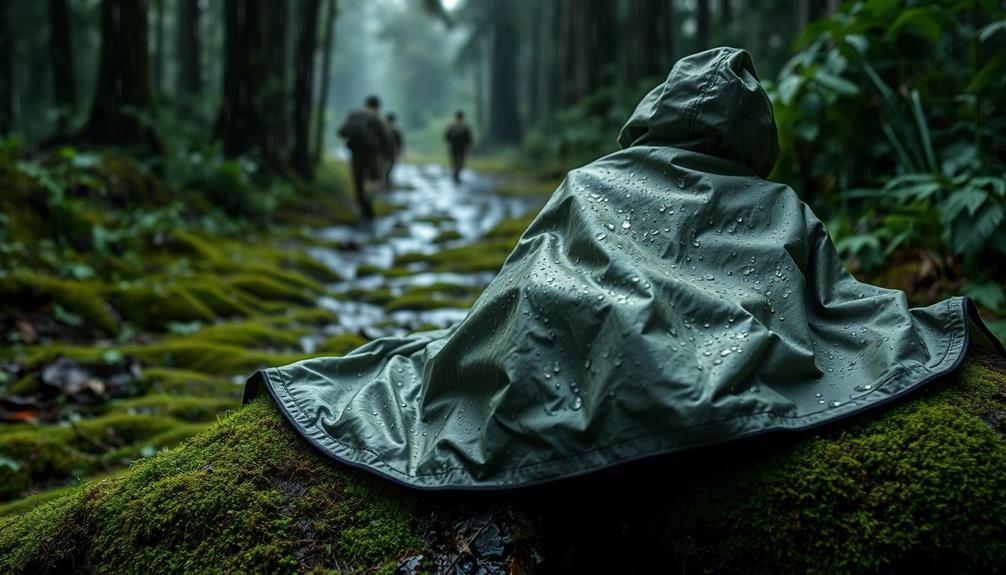Staying safe in the wild means knowing how to handle wildlife, staying aware of your surroundings, and being prepared for any challenges. Keep a safe distance from animals, especially mothers with young ones, and avoid feeding wildlife to prevent aggression. Use your senses to navigate and make noise while hiking to alert wildlife of your presence. Always pack essential gear, including a first aid kit and reliable navigation tools. Don't forget to respect the environment by following Leave No Trace principles. As you discover more tips, you'll become better equipped to enjoy your wilderness adventures safely.
Key Takeaways
- Maintain a safe distance from wildlife: 100 yards from bears/wolves and 25 yards from other animals to prevent aggressive encounters.
- Use noise and movement to alert wildlife of your presence, reducing the chances of surprising them during hikes.
- Familiarize yourself with local wildlife behaviors and travel in groups to enhance safety and minimize unexpected encounters.
- Carry essential gear like a first aid kit, multi-tool, and water purification methods to prepare for emergencies while in the wild.
- Follow Leave No Trace principles to protect the environment, dispose of waste properly, and respect fellow outdoor enthusiasts.
Preparing for Wildlife Encounters

When venturing into the wild, preparation is key to guaranteeing your safety during potential wildlife encounters. First, always maintain a safe distance from wildlife: keep at least 100 yards from bears and wolves, and 25 yards from other animals. If an animal moves because of your presence, you're too close. Avoid approaching or petting wildlife, as this can provoke aggressive behavior. Feeding wild animals is a big no-no; it fosters dependency on humans and can lead to aggression.
Make noise while hiking to avoid surprising animals. Shouting, singing, or clapping helps alert wildlife to your presence. Bear bells can be useful, but they might not be loud enough. Steer clear of hiking at dawn or dusk, when animals are most active, and wear proper clothing to protect against snakes. Additionally, be cautious of your surroundings to identify potential threats before they become an issue.
If you encounter an animal, stay calm. Back away slowly and avoid startling it. Make yourself appear larger and talk to the animal to signal your presence. Guarantee it has an escape route, and always carry bear spray as a last resort. Understanding animal behavior—like their territorial instincts—can greatly enhance your safety in the wild.
Maintaining Awareness

Staying aware of your surroundings is essential for ensuring your safety in the wild. Use your peripheral vision to maintain a 360-degree awareness of what's happening around you, including above and below. Recognize landmarks to help you navigate back to safety, and stay informed about the weather to avoid sudden storms.
Constantly monitor your surroundings, including what's behind you, by following the principle of "check your six." Stay alert to anticipate potential threats or changes in your environment. Use all your senses to gather information, and keep track of time and the sun's position for effective navigation. Following waterways can also guide you towards populated areas, enhancing your chances of finding help.
Know the local terrain and be aware of hazards like dense vegetation or steep areas. Familiarize yourself with available resources, including water sources and how to purify it, as well as food and shelter materials. Monitor your personal condition by staying hydrated and managing your energy levels. Remember to dress appropriately for the weather and activity, and maintain a positive attitude to help boost morale. Staying vocal can also aid in being located by search teams if needed.
Handling Wildlife Encounters

Maintaining awareness in the wild also means being prepared for potential wildlife encounters. Keep your distance from wild animals; this helps avoid unwanted interactions. Never feed, catch, or pet them, as this can change their behavior and lead to aggression. If you spot a mother with her young, steer clear—she'll likely defend her offspring fiercely.
In case you encounter specific wildlife, your reaction matters. If you see a mountain lion, stay calm and back away slowly, making yourself look larger by raising your arms. For bears, make noise to prevent surprising them and avoid cornering them. With coyotes and deer, simply avoid them and never feed them. If a moose approaches, give it space and watch for warning signs. If it charges, run and find cover.
Lastly, consider defensive measures. Bear spray can deter aggressive animals, but it requires proper training. Always hike in groups to lower the risk of surprising wildlife and secure your food to avoid attracting them. Remember, the best prevention against rabies is to keep your distance from wild animals; if you do get bitten or scratched, wash the area immediately and seek medical help. Additionally, reporting injured or aggressive animals to authorities is crucial to ensure safety for both humans and wildlife.
Managing Camp and Trail Impact

When you're camping in the wild, practicing campfire safety is essential to prevent wildfires and protect fragile habitats. Make sure to use established fire rings, and always extinguish your fire completely before leaving. By minimizing habitat disturbance, you help preserve the natural beauty and integrity of the environment for future campers. Additionally, sustainable trails can direct use away from critical habitats, further supporting the preservation of these delicate ecosystems.
Campfire Safety Practices
Campfire safety practices are essential for protecting both the environment and your camping experience. When selecting a campfire location, find a flat, open spot at least 15 feet away from tents and gear, and 100 feet from cliffs. Avoid areas with overhanging branches and check local regulations regarding campfires.
Before lighting your fire, clear a 10-foot radius around the site, removing all flammable materials. Create a shallow depression in the center and surround it with a circle of rocks to form a fire ring. Gather tinder, kindling, and firewood, but never use flammable liquids to start your fire. Remember that permits are required for campfire setup to ensure safety and compliance with local regulations.
Keep your campfire small and manageable, and always have water and a shovel on hand. An adult should monitor the fire at all times, keeping children and pets at a safe distance. Be mindful of wind conditions, as gusts can spread sparks.
When it's time to extinguish the fire, drown it with water, stir the ashes with a shovel, and add soil to guarantee everything is smothered. Finally, check for any remaining heat and dismantle the fire ring only after confirming the area is cool to the touch.
Minimizing Habitat Disturbance
To minimize habitat disturbance while enjoying the outdoors, you should choose campsites and trails wisely. Select well-impacted campsites to limit new disturbances, and focus your activities on already disturbed areas. This approach helps preserve the surrounding environment. Regular assessments of trail conditions, including numerical classes, can guide your choices in minimizing impacts on trails.
Proper disposal of human waste is essential to prevent soil and water pollution, so always use designated facilities. By keeping campsites attractive and maintaining amenities like fire rings, you can discourage the creation of new sites that disrupt nature.
When it comes to trails, stick to established routes. Use sustainable paths with proper drainage to reduce erosion, and help close lightly used trails by naturalizing them with local debris. Limiting trail development to high-traffic areas helps protect more pristine habitats.
Educate yourself and others about the importance of staying on trails to minimize stress on wildlife. If you bring a dog, keep it on a leash to reduce disturbances to local fauna. Finally, consider implementing practices like boot washing stations to prevent the spread of invasive species. By following these guidelines, you can enjoy the outdoors while safeguarding its delicate ecosystems.
Considering Weather Conditions

As you plan your outdoor adventures, considering weather conditions is essential for guaranteeing your safety and enjoyment. Start by checking the current and expected temperatures for the day, paying attention to the "feels like" temperature. Aim for moderate conditions when scheduling your activities. High temperatures require sunscreen and extra hydration, while cooler weather demands additional clothing layers.
Next, assess precipitation risks. Look at the likelihood of rain, snow, or hail, and use this information to decide whether to reschedule your plans or pack necessary gear like umbrellas. Monitor timing, as heavy storms can lead to flash floods—stay alert and seek higher ground if needed. It is also important to monitor sky conditions for signs of thunderstorms, such as towering clouds and darkening skies.
Don't forget about wind and air quality. Strong winds can impact your outdoor activities, increasing the risk of flying debris. Always check the Air Quality Index to guarantee it's safe to be outside. Low air quality can aggravate respiratory issues, so stay informed.
General Safety Tips

When you're out in the wild, keeping a safe distance from wildlife is essential for your safety and theirs. It's also important to travel in groups, as there's strength in numbers and support if something goes wrong. Additionally, knowing how to create potable water can be a crucial skill in case of emergencies, ensuring you stay hydrated during your adventure. By following these guidelines, you can better protect yourself and enjoy your adventure.
Maintain Safe Distances
Maintaining safe distances from wildlife is essential for both your safety and the well-being of the animals. Different species require varying distances to feel secure. For instance, large ungulates like elk need a buffer of 500 to 1,000 meters, while hawks and eagles prefer at least 400 meters. Smaller animals, such as medium-sized rodents, can be impacted from as close as 50 meters.
To guarantee you're respecting these distances, familiarize yourself with local wildlife species and their behaviors. Stay alert for signs of wildlife, like tracks or droppings, and make noise to announce your presence. If you encounter an animal, maintain a calm demeanor and back away slowly. Research and planning can help you understand the specific wildlife behaviors in the area you are camping.
When camping, securely store food and scented items in bear-resistant containers or hang them from trees far from your site to avoid attracting wildlife. Always keep your distance and never attempt to feed or approach wild animals. By respecting these boundaries, you not only protect yourself but also help minimize human impact on their habitats, promoting healthier ecosystems for everyone involved.
Travel in Groups
Traveling in groups considerably enhances your safety while exploring the wild. Aim for small to moderate-sized groups to minimize your impact on the environment and improve manageability. If you're part of a larger group, split into smaller parties for easier navigation. Make certain you have at least two leaders or experienced hikers, mixing both experienced and inexperienced members to promote learning and safety.
Before your trip, establish clear communication protocols so everyone knows how to inform the leader if someone leaves the group. It's vital that all members understand the plan and their roles. Regular check-ins can keep everyone engaged and aware of their surroundings. Remember to yield to smaller groups and horses by stepping aside on the trail. Additionally, ensure that all group members are educated on the importance of weather preparedness to handle any unexpected changes in conditions.
Prepare for emergencies by packing essential items like whistles, first aid kits, and extra clothing. Familiarize yourself with protocols for lost hikers, such as the “hug a tree” policy. Confirm all group members know the emergency procedures and how to handle extreme weather or hazards. By traveling in a well-organized group, you’ll greatly increase your safety and enjoyment in the wild. Additionally, make sure to pack enough food and water for your journey, as well as a map and compass for navigation. Safe route planning is crucial, so be sure to research the area and know the potential risks and challenges you may encounter. Always inform someone of your itinerary and expected return time before heading out on any outdoor adventure.
Understanding Animal Behavior

Understanding animal behavior is essential for staying safe in the wild. Animals have specific feeding times and locations, so it's vital to avoid attracting them by not keeping food near you. Hungry animals may become aggressive if they feel their food source is threatened. Feeding wildlife disrupts their natural behaviors, so it's best to refrain from doing so.
Many animals are protective of their territory and young, especially during breeding seasons. Approaching wildlife babies or mothers can provoke a fierce defensive response. To minimize surprises, make noise while hiking to alert wildlife of your presence. Always keep a safe distance from large animals like bears and wolves, as cornering a bear can trigger aggression. Additionally, being aware of local wildlife news can help you stay informed about any recent sightings or incidents that may affect your safety.
Seasonal behaviors also play a role in how animals interact with their environment. In spring, you might witness courtship and birthing, while summer brings higher animal densities and group behaviors. Remember, wild animals generally avoid humans but may attack if they feel threatened. In encounters with predators, stay calm, maintain your position, and appear larger. Reporting injured or aggressive animals to authorities is always a better option than trying to help them yourself.
Essential Gear for Safety

When you're in the wild, having the right gear can make all the difference in ensuring your safety. Start with a survival Swiss army knife or multi-tool; it's invaluable for tackling various tasks. Don't forget pliers, a stainless steel blade, a shovel, and a saw for added versatility. Trekking poles can help maintain balance on uneven terrain, while a sharpening stone keeps your tools in top shape.
For illumination and signaling, pack a tactical flashlight with extra batteries, emergency candles, and a small mirror. A fire-starting kit—complete with matches or lighters—can be a lifesaver. Glow sticks or flares are optional but handy for visibility.
Staying hydrated is vital, so include water purification tablets and a reliable water filtration device. A sturdy water container, like a metal bottle, should hold at least 750 ml. Additionally, aim for a weight limit of 25% of your body weight when packing your gear to ensure ease of movement.
Lastly, don't skimp on first aid supplies. Basic bandages, medical tape, and antiseptics are essential. Include tweezers and first aid scissors to handle unexpected injuries. With this gear, you'll be better equipped to stay safe and enjoy your adventure in the wild.
Responsible Camping Practices

How can you guarantee a positive experience for both yourself and the environment while camping? Responsible camping practices are essential. Start by researching campground regulations and weather conditions before you head out. Travel in small groups to minimize your impact, and repackage food to reduce waste. Always bring a GPS or a map for navigation and check your vehicle's condition for the terrain you'll encounter.
When setting up camp, stick to designated campsites and durable surfaces like rock or gravel. Travel and camp on durable surfaces keeps your campsite at least 200 feet away from water sources to protect the ecosystem. It's important to remember that financial aid sources can assist you in managing costs associated with your trip, including camping fees. Engaging in positive affirmations can also enhance your camping experience by fostering a mindset of gratitude and mindfulness. Be mindful of waste disposal by using on-site facilities and biodegradable soap. Remember to leave natural resources undisturbed and keep campfires small, using established fire rings.
Lastly, respect wildlife and fellow campers. Keep your distance from animals and control your pets at all times. Yield to trail users and keep noise levels down. By following these practices, you'll assure a safe and enjoyable camping experience for yourself and the environment.
| Responsible Camping Practices | Tips |
|---|---|
| Research campground rules | Always check in advance |
| Camp on durable surfaces | Protect the ecosystem |
| Dispose of waste properly | Use on-site facilities |
| Respect wildlife and others | Keep a safe distance
Frequently Asked Questions
What Should I Do if I See a Baby Animal Alone?
If you see a baby animal alone, first assess the situation. Look for signs of a nest or if the mother is nearby. Observe quietly to see if she returns. If the animal seems injured or truly orphaned, use gloves to carefully pick it up and place it in a safe container. Keep it calm and warm, but don't feed it. Contact a licensed wildlife rehabilitator for help as soon as you can.
How Can I Tell if an Animal Is Sick or Dangerous?
You know what they say, "A sick animal often hides its pain." To tell if an animal is sick or dangerous, look for signs like decreased activity, abnormal posture, or changes in appetite. You might notice increased aggression or restlessness. Pay attention to physical signs too, like vomiting, lumps, or foul odors. If the animal seems unusually vocal or reactive, it could be a warning. Trust your instincts and keep your distance if something feels off.
Are There Specific Animal Sounds I Should Recognize?
Yes, there are specific animal sounds you should recognize. For instance, a timber rattlesnake's rattle warns you of its presence, while bear growls indicate agitation. Cougars hiss or growl when feeling threatened. You'll also hear alarm calls from animals like antelope, which signal danger. Being aware of these sounds helps you assess your surroundings and respond appropriately to potential threats. Understanding these cues enhances your safety in nature.
What First Aid Supplies Are Essential for Wildlife Injuries?
When dealing with wildlife injuries, you'll want to have essential first aid supplies on hand. Pack various sizes of bandages and gauze pads for wound coverage. Antiseptic wipes and antibiotic ointment are vital for cleaning and preventing infection. Include pain relievers like ibuprofen or acetaminophen. Don't forget a clean cloth for applying pressure, mild soap for cleaning wounds, and gloves for your protection. Having these items can make a significant difference in emergencies.
How Do I Report a Wildlife Encounter or Sighting?
When you stumble upon a wildlife encounter, it's like finding a hidden treasure in nature. To report it, gather key details: the species, location, date, and any notable behavior. If it's an emergency, don't hesitate to call 9-1-1. For non-urgent sightings, use designated online forms. Remember, your observations help wildlife authorities keep our furry friends safe and healthy, so your input truly makes a difference in their world!
Conclusion
Staying safe in the wild means finding balance; you're both an explorer and a guardian of nature. While you embrace the thrill of wildlife encounters, remember to respect their space. Awareness sharpens your senses, but don't let fear overshadow your adventure. Equip yourself with essential gear, yet stay flexible to nature's whims. By practicing responsible camping, you not only protect yourself but also preserve the wilderness for generations to come. Enjoy the wild, but let wisdom guide your journey.










